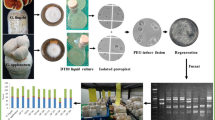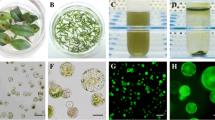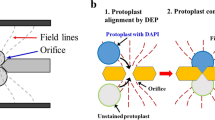Abstract
Isolated protoplasts of Ulva pertusa and Enteromorpha prolifera were electrically fused. Treatment of protoplasts in 1% protease for 15–20 min prior to fusion enhanced fusion ability. Protoplasts from each fusion partner were mixed together in 1:1 ratio in low conductivity electrofusion solution at a density of 1 × 105 cells ml−1 before subjecting them to electrofusion. The protoplasts were aligned in AC field (1MHz, 25 V for 10–15 s) and subsequently fused by a high intensity single DC pulse of 250 V for 25 μs duration. Fusion buffer supplemented with 1 mM calcium and 1 mM magnesium yielded optimum fusion frequencies (about 18–24%). Entrapment of fusion treated cells inside agarose/agar plate facilitated marking and regeneration of fusion products. The regeneration patterns of fused protoplasts were similar to normal (unfused) protoplast development. Most of the regenerated plants from fusion products had a thallus similar to either U. pertusa type or E. prolifera type. Although some of the plants of the former were morphologically similar to U. pertusa, but most had a higher growth rate (1.9 to 1.5 times) than U. pertusa. Furthermore the thallus of some plants had a characteristic irregular and dentate margin, which was never observed in the parental type.
Similar content being viewed by others
References
Bates GW, Saunders JA, Sowers AE (1987) Electrofusion: principles and applications. In Sowers AE (ed.), Cell Fusion. Plenum, New York, 367–395.
Binding H (1974) Fusion experiments with isolated protoplasts of Petunia hybrida L. Z. Pflanzenphysiol. 72: 422–426.
Carlson PS, Smith HH, Dearing RD (1972) Parasexual interspecific plant hybridization. Proc. Natl. Acad. Sci. 69: 2292–2294.
Evans DA, Bravo JA, Kut SA, Flick CE (1983) Genetic behaviour of somatic hybrids in the genus Nicotiana: N. otophora and N. tabacum and N. sylvestris and N. tabacum. Theor. appl. Genet. 65: 93–101.
Fish N, Karp A, Jones MGK (1988) Production of somatic hybrids by electrofusion in Solanum. Theor. appl. Genet. 76: 260–266.
Fujita Y, Migita S (1987) Fusion of protoplasts from thalli of two different color types in Porphyra yezoensis Ueda and development of fusion products. Jap. J. Phycol. 35: 201–208.
Fujita Y, Saito M (1990) Protoplast isolation and fusion in Porphyra. Hydrobiologia 204/205: 161–166.
Galbraith DW (1984) Selection of somatic hybrid cells by fluorence-activated cell sorting. In Vasil IK (ed.), Cell Culture and Somatic Cell Genetics of Plants, Vol. 1. Academic Press, New York, 433–447.
Gleba YY, Sytnik KM (1984) Protoplast fusion. Genetic Engineering in Higher Plants. In Frankel R (ed.), Monographs on Theoretical and Applied Genetics, Vol. 8. Springer-Verlag, Berlin, 220 pp.
Kameya T (1979) Studies on plant cell fusion: effect of dextran and pronase E on fusion. Cytologia 44: 449–456.
Kao KN (1977) Chromosomal behaviour in somatic hybrids of Soybean-Nicotiana glauca. Mol. Gen. Genet. 150: 225–230.
Kohn H, Schieder O (1985) Somatic hybrids in tobacco mediated by electrofusion. Plant. Sci. 38: 121–128.
Lawrence J Nea, Bates GW (1987) Factors affecting protoplast electrofusion efficiency. Plant Cell Rep. 6: 337–340.
Lucy JA (1984) Fusogenic mechanisms. In Everd J, Whelan J (eds), Cell Fusion. Ciba Foundation Symposium 103. Pitman, London 28–39.
Melchers G, Labin G (1974) Somatic hybridization of plants by fusion of protoplasts. 1. Selection of light resistant hybrids of ‘haploid’ light sensitive varieties of tobacco. Mol. Gen. Genet. 135: 277–294.
Nagata T (1978) A novel cell fusion method protoplasts by polyvinyl alcohol. Naturwissenschaften 65: 263–264.
Migita S (1985) The sterile mutant of Ulva pertusa Kjellman from Omura bay. Bull. Fac. Fish. Nagasaki Univ. 57: 33–37.
Ohiwa T (1975) Behaviour of cultured fusion products from Zygnema and Spirogyra protoplasts. Protoplasma 97: 185–200.
Ohno-Shosaku T, Okada Y (1984) Facilitation of electrofusion of mouse lymphoma cells by the proteolytic action of protease. Biochem. Biophys. Res. Commun. 120: 138–143.
Primke M, Bergers S, Schweiger H (1978) Protoplasts from Acetabularia: isolation and fusion. Cytobiologie 16: 375–380.
Reddy CRK, Fujita Y (1989) Protoplast isolation and fusion of Ulva pertusa and U. conglobata. In Miyachi S, Karube I, Ishida Y (eds), Current Topics in Marine Biotechnology. The Society of Marine Biotechnology, Tokyo, 235–238.
Reddy CRK, Migita S, Fujita Y (1989) Protoplast isolation and regeneration of three species of Ulva in axenic culture. Bot. mar. 32: 483–490.
Reddy CRK, Fujita Y (1991) Regeneration of plantlets from Enteromorpha (Ulvales, Chlorophyta) protoplasts in axenic culture. J. appl. Phycol. 3: 265–275.
Saga N, Polne-Fuller M, Gibor A (1986) Protopolasts from seaweeds: production and fusion. Beih. Nova. Hedwegia 83: 37–43.
Saito M, Fujita Y (1991) Optimization of fusion conditions in the polyethylene glycol and electric stimulation methods for the protoplasts of Porphyra. Nippon Suisan Gakkaishi 57: 919–925.
Senda M, Takeda J, Abe S, Nakamura T (1979) Induction of Cell Fusion of plant protoplasts by electrical stimulation. Plant Cell Physiol. 20: 1441–1445.
Vienken J, Ganser R, Hampp R, Zimmermann U (1981) Electric field induced fusions of isolated vacuoles and protoplasts of different developmental and metabolic provenience. Physiol. Plant, 53: 64–70.
Zhang D (1983) Study on the protoplasts preparation, culture and fusion of somatic cells from two species of green algae — Ulva linza and Monostroma angicava Kjellm. J. Shandong Coll. Oceanology 13: 57–65 (in Chinese withe English summary).
Zimmezrmann U (1982) Electric field mediated fusion and related electrical phenomenon. Biochem. Biophys. Acta 694: 227–277.
Author information
Authors and Affiliations
Rights and permissions
About this article
Cite this article
Reddy, C.R.K., Iima, M. & Fujita, Y. Induction of fast-growing and morphologically different strains through intergeneric protoplast fusions of Ulva and Enteromorpha (Ulvales, Chlorophyta). J Appl Phycol 4, 57–65 (1992). https://doi.org/10.1007/BF00003961
Received:
Revised:
Accepted:
Issue Date:
DOI: https://doi.org/10.1007/BF00003961




